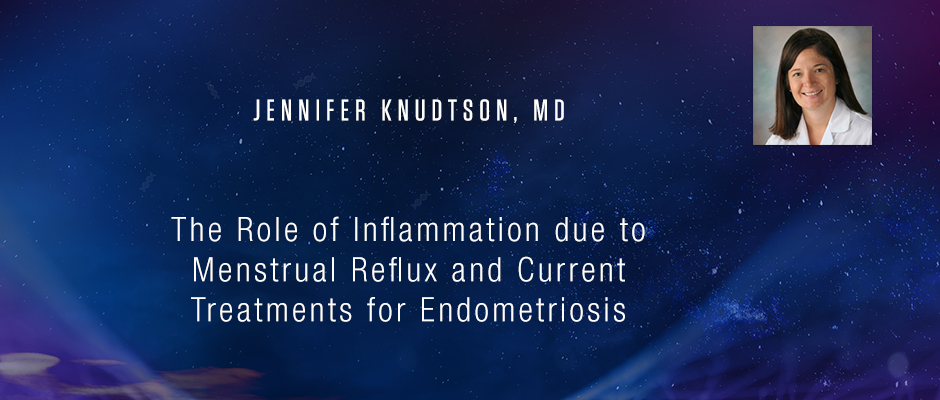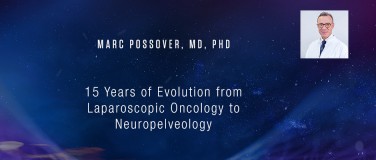Jennifer Knudtson, MD - The Role of Inflammation due to Menstrual Reflux and Current Treatments for Endometriosis
Endometriosis Foundation of America
Medical Conference 2019
Targeting Inflammation:
From Biomarkers to Precision Surgery
March 8-9, 2019 - Lenox Hill Hospital, NYC
https://www.endofound.org/medicalconference/2019
Good morning. Thank you for the opportunity of speaking here today. Everyone's a little bit taller than me. So today we're going to discuss the role of inflammation in the attachment of reflexed endometrial cells and current treatments in endometriosis.
Our objectives are one to discuss the current results from a study we did through ACOG to look to see how our providers treating endometriosis look at medication surgeries and other treatment options. And then also to review the role of inflammation on attachment of refluxed endometrial cells in the development of endometriosis.
So the background from the survey, there's multiple medical treatments and I'm sure we've heard a lot about them this weekend for endometriosis and a lot of them in the studies show, they have similar efficacy. And so a lot of management styles vary. There is a recent clinical experts series that emphasize treating the whole patient. So medication, surgeries, pain management and possibly other alternative therapies. So the survey was really trying to find out what are we doing, how are we treating our patients, especially the ones with endometriosis, with pain and not desiring to get pregnant. Specifically looking at the United States because the most of the other surveys look from not in the United States and so we're trying to see really what are we doing.
So as a cross-sectional survey sent randomly a 5,000 members of the American College of Obstetricians and Gynecologists, it was sent through Qualtrics. That survey included 22 questions designed to assess how are we using our medicine surgeries? Are we prescribing opioids, are we using other non-hormonal therapies? And then are we incorporating pain management or a psychological counseling for these patients? This study is mainly descriptive, but we did look at some differences with Fishers Exact and the Mann-Whitney U.
So this is our demographics of our results. Overall, there were 345 physicians that answered the survey. Our adjusted response rate was much lower than hoped for, but it took into account unopened emails, bounced emails, physicians that didn't have a right email anymore. Overall, our responders, the majority were female. There are 68%. The majority were generalist and the average age was 46 The years in practice average was 15 and the most common practice type at 38% was a partnership or a group practice.
So when we look at what's a first line treatment, what we found were that the majority were using continuous OCPs, the next were cyclic OCPs. And then when we saw beyond that ... Oops, sorry. Were progesterone and NSAIDs.
Some of the results from the medicine part of the survey, we found that the most common treatments for suspected bowel endometriosis medically 32% use continuous combined OCPs, 24% use GnRH agonist with add-back. 65% are considering the new GnRH antagonist. And the majority do offer a postoperative hormone suppression. The most common being continuous OCPs and second to that was GnRH agonist with add-back.
From the surgery part, the most common surgical treatment for endometriosis was now on-robotic laparoscopy. The surgical management was most often pursued when previous medical management had failed. Unfortunately 90%, when they are diagnosing endometriosis, they are treating it at the same time at surgery. Since the average time and practice was 15 years, we look to see are there different practice patterns based on either how long they were practicing, what type of practice, and we did find that physicians that were practicing greater than 15 years were more likely to opt for surgery than those that had been practicing less than 15 years.
And we also looked at the different treatment options and how the practice pattern changed. And we do see the longer you've been in practice, the more like you are to prescribe cyclical OCPs, more likely to prescribe progesterone and the agonist.
When we looked at pain and different alternative treatments, we saw that the majority of providers are prescribing NSAIDs, only about 20 per six were prescribing opioids, 34% acupuncture and 44% psychological support.
When kind of looking how do the practice patterns combined, we saw that physicians that prescribe opioids are more likely to refer for psychological care along with physicians that refer to acupuncture, more likely to refer to psychological care.
Just incorporating psychological care. The majority of physicians thought that these chronic pain endometriosis patient should be referred for a psychological care, but only about 15% actually refer their patients. And because the majority of them are Ob-Gyns, they don't have the training in order to be able to counsel the patients themselves.
So just a brief kind of conclusions from our study. The majority of responding providers are practicing evidence-based medicine. Most physicians recognize a need for kind of a multidisciplinary approach and only a minority of providers utilize alternative treatment.
Okay, so now we're switching gears to more basic science translational work. So talking about the role of inflammation in endometriosis. So inflammation, what we're here to talk about at the conference is one of the most important pathologic processes in endometriosis. The hallmarks of inflammation are productions of cytokines, prostaglandins and infiltration of immune cells. And that's what we see in these lesions. Different studies have shown that you get in the intra peritoneal fluid, increased fluid like fluid leukocytes, cytokines, growth factors. And this suggests that there probably is some type of immune dysregulation in these patients with endometriosis.
So kind of reviewing the most common mechanism that's been proposed for the development of endometrioses, Samson's theory. You get the refluxed endometrial cells from the tubes or retrograde menstruation and this usually is composed of glandular epithelial cells and stromal cells and then these endometrial cells have to attach and invade. Most commonly on the peritoneum. You get the immune response with the macrophages. You get the neovascularization and encapsulation which enters elision nerve fibers and then more immune response or natural killer cells, T cells and B cells.
When we look at the different molecular models for the pathogenesis, the cells that survive in these endometriosis lesions, one way they're different is they really have this resistance to apoptosis. When we look at eutopics, so tissue from the uterus, from the endometrium compared to ectopic tissue that are actually in the lesions there are different functional abnormalities and a lot of this we think originates from different epigenetic changes. Is it hypo-methylation of the promoters for SF-1 or estrogen receptor Beta. And really all these combine to induce a chronic inflammatory response in this self-perpetuating cycle.
So what are the major contributors to inflammation? Well, in the endometriotic and the lesion stroma cells, they're a major source of inflammatory cytokines and prostoglandins. And then every month when these women have these recurrent episodes of bleeding, the macrophages try to go to the blood and remove it and this increases more macrophages. And then we'll talk about today how Estradiol, one of the main propagators of endometriosis induces inflammation also.
So when we look at attachment and inflammation, we have to think menstruation is actually a chronic inflammatory process with 40% of the menstrual tissue having neutrophils, macrophages, and natural killer cells. The way we've been able to study endometriosis in the lab is through two different ways. One in vitro, we can use chicken chorioallantoic membrane. It's not very well characterized and there might be some species specific reason. So we don't use it that often. There has been studies looking at an amniotic membrane also not commonly used. Most commonly we use human explants or monolayer cell culture models with simulated peritoneum. So usually cell lines are peritoneal cells. There's also in vivo mouse models. Two most common ways you can do mouse models is doing a surgery and implanting the endometrium in the mouse. If we're looking at attachment, we want to concentrate on the models that actually take the cells and inject them into the mouse so those cells actually have to attach to the peritoneum. This is a picture from an electron microscope kind of looking at attachment in the lab. And so you see the peritoneum and then these are a combination of epithelium and stromal cells. And then here's invasion about 48 hours after.
So different studies have reported increased levels of acute inflammatory cytokines and there's thought that these help enhance the adhesion of the shed endometrial cells onto the peritoneum. The most common ones that have been studied are IL-1B, IL-B and TNF. And then the IL-8 and RANTES have also been shown to acute macrophages and other inflammatory cells. There is a recent study that looked at women with endometriosis versus women without at time of surgery and looked at their different inflammatory cytokines and two weeks later they found that women with endometriosis that had lesions removed actually had decreased inflammatory cytokines. They listed TSF, IL-2, IL-8, and IL-10. What was interesting is they found that these cytokines actually started to increase about three months later and that the women with endometriosis had more inflammatory cytokines in their blood also.
When we look at the in vitro studies with TNF-α what we see ... Now, there's one study where they treated the peritoneal [inaudible 00:11:58] cells with TNF-α, and they found that the attachment increased with a stromal cells in a dose dependent manner, but it was very specific for those peritoneal cells. So they went and they treated just the stromal cells. They didn't see that same increase in attachment. Another study also treating the peritoneum [inaudible 00:12:17] cells used TNF-α, IL-6 and IL-8 and they didn't find that same increase in attachment. They actually found the opposite, a decrease in attachment. And so these findings might suggest that TNF-α differently affects the epithelium and stromal cells in attachment to the PMCs.
So when you talk about inflammation, we think about macrophages. CSF are colony stimulating factor one is a cytokine produced by macrophages. It's been found to be higher in levels in peritoneal fluid in women with endometriosis versus controls and also even higher in ectopic tissues with endometriosis.
Here's a pictorial representation courtesy of Dr Tekmal and what we see here. So in a normal, you have few macrophages when they have the retrograde menstruation, endometrial cells, but then these cells undergo apoptosis. In a patient with endometriosis they might have more oxidative stress with increased macrophages, you get the colony stimulating factor increase because you have more of the macrophages. And then from there you have upregulation of more cell cycle genes, increased attachment implantation and growth.
To show specifically how CSF-1 effected attachment they did a mouse model and they used a CFO one knockout mouse model showing that there were decreased number of lesions. And so they had a wild type mice and then a CSF knockout. And so they would take the tissue from the endometrium from the donor, and then inject it directly into the recipient. And then see after 48 hours how many lesions there were. And then they did the same experiment with a knockout mice and they found that there were significantly decreased number of lesions. So 8 compared to 0.8. And then looking at the crossover model to see, well is it the endometrium contributing or is it the peritoneum? And so when we look at the donor's knocked out and you put it into the recipient, so really looking at that endometrial component, you see there's not a difference compared to control. But when you knock out the CSF component in the recipient, so the peritoneal component's knocked out, you'd significantly see a decrease.
From there there was a drug study with a Imatinib, which targets CSF-1 receptor. And so looking to see if we could target the tissues and block the receptor, what would the response be? And so in the control, same about eight lesions. Imatinib was given for a week, either once a day or twice a day. And both the lesions were significantly decreased in those groups. And the crossover experiment when the donor was a control but the peritoneum, so the recipient was treated with Imatinib. There is no difference between wild type and the crossover. But when the donor was treated, there was a significant decrease.
So we talk about estrogen a lot being a promoter in endometriosis. There's two main estrogen receptors, estrogen receptor α and β. And what we've seen kind of overall in endometriotic, so in the lesion stromal cells compared to eutopic in the uterus endometrial stromal cells, there is suppressed estrogen receptor α, but increased estrogen receptor β. We think estrogen receptor β is that key mediator of estrogen action in these cells. And we think that an influence of TNF-induced apoptosis increases IL-1B.
Here's a schematic from one of Boolean's papers looking at kind of the response in the actual endometriotic lesion, and so we see that Estrodiol acts via ERβ and that stimulates COX2 through the arachidonic acid pathway, increasing that PGE2 and inflammation. So showing how estrogen and inflammation are really contributing to the lesion.
So prostoglandins are also involved. They are locally produced hormones above the inflammation and pain. Prostoglandin E2 and F2α are produced in excess and uterine and endometriotic tissues in women with endo and there are kind of different mechanisms. The one we just saw, ERβ through the COX2.
When I look to see where there any attachments looking at prostoglandins and endometriosis, there weren't any in vitro attachments. So was one xenograft mouse model and they used a blocker for the prostaglandin, F2α. They inoculated with human immortalized cells into the cavity of nude mice and gave some of the mice the antagonists to PG F2α and the other's a placebo. And they found with the antagonists there were a decreased number of lesions in size and of note, they did not treat these mice with estrogen. So that didn't really influence the prostaglandin pathway. But at the same time these mice were cycling and so they might not have had as many lesions as if they had given it.
So there's been different studies on estrogen receptor β. One of the big ones was published by Han et al in Cell in 2015 they looked at when we overexpress ERβ, they found that it increased endometriotic cells attachment to peritoneum. And they found that in vitro and they also found it in a mouse model. When they did their mouse model, they used skin mice with immortalized sales and luciferase and you can see after 21 days there were increased number of lesions in the ERβ overexpressed versus the control. Looking one step further, in the mechanism to this, what they found was that when they added TNF-α, which can be a apoptotic producer, that the cells that had ERβ overexpressed, they were able to kind of overcome those apoptosis signals and not have increased apoptosis markers compared to control.
So their pictorial representation of what they found were that when these fragments are retrograde in healthy women, they go through the TNF-α immunosurveillance and they're cleared by apoptosis. But in endometriosis, because ERβ's increased, they have this anti-apoptosis mechanism and they kind of overcome the apoptotic machinery. And then they also increased an inflamma, so in probably IO-1β, which also increases adhesion and proliferation.
So in our lab, kind of what we've been working on is also knocking out ERβ and seeing how it affects attachment. And so we found, if we knock it out, it decreases attachment in the stromal cells in the lab. And also if we knock it out in the epithelials, it decreases the attachment.
We did a mouse model and were able to see that when we use a knockout, knockout miles compared to control, there are decreased number of lesions also. But when we did the different crossover experiments from the wild type to the knockout or the knockout to the wild type, there wasn't a statistical difference. And so right now we're working on looking at some of the different cytokines and pathways for why this might be true.
So in conclusion, inflammation plays a role in the development of endometriosis. Specifically today we looked at attachment. There are different inflammatory cytokines and pathways involved. Hopefully with more research, targeting the inflammatory reaction may be a potential treatment for these patients.
And I just wanted to thank my mentors and my lab and then the different research support and especially the Endometriosis Foundation.
So thank you.










